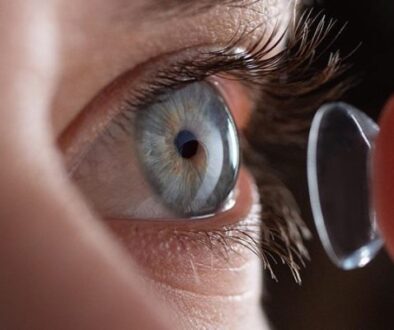How Do Toric Contact Lenses Work for Astigmatism?
What Are Toric Lenses?
Toric lenses are specialized contact lenses designed to correct astigmatism, a common vision problem where the cornea or lens of the eye is irregularly shaped, causing light to focus on multiple points on the retina instead of one.
Unlike standard contact lenses that are spherical, toric lenses have a unique shape that resembles a slice of a donut. They come in various types, including soft lenses, rigid gas permeable (RGP) lenses, and intraocular lenses (IOLs).
How Toric Lenses Work

Toric lenses feature different refractive powers in their horizontal and vertical orientations, allowing them to address the irregular corneal shape that causes astigmatism. To stay in the correct position on your eye, toric lenses have special features like thicker and thinner areas, added weight at the bottom, or a slightly flattened edge.
Who Can Benefit from Toric Contact Lenses?
Toric lenses are ideal for individuals with astigmatism, including regular, corneal, and lenticular astigmatism. They can also correct other vision issues like nearsightedness or farsightedness simultaneously, making them a versatile solution for many patients.
Types of Toric Lenses
- Soft toric contact lenses: Comfortable and easy to adapt to
- Rigid gas permeable toric lenses: Offer excellent clarity and durability
- Toric intraocular lenses: Used in cataract surgery or refractive lens exchange
Disposable and colored options are also available to suit different preferences and lifestyles.
Benefits of Toric Lenses
- Improved visual acuity for astigmatism
- Reduced dependence on glasses
- Some lenses offer UV and blue light protection
- Suitable for active lifestyles
How Toric Lenses Stay Put: Smart Design Secrets
1. Core Stability Features
-
Weighted Base (Ballasting):
How it works: The Thicker, slightly heavier bottom edge acts like a “keel” to prevent spinning.
Patient benefit: Lenses self-correct position with each blink. -
Strategic Thickness Zones:
How it works: Alternating thin/thick areas create natural alignment with corneal curves.
Patient benefit: Eliminates midday rotation during screen use. -
Precision Truncation:
How it works: Flattened lower edge locks against eyelid like a puzzle piece.
Patient benefit: Stability during rapid eye movements (driving, sports). -
Invisible Markings:
How it works: Micro-laser engravings (e.g., “123”) visible only to eye doctors during fittings.
Patient benefit: Enables millimeter-perfect axis alignment.
2. Why Stability Isn’t Just Convenience—It’s a Medical Necessity
-
Rotation Risks:
-
Even 10° misalignment = 30% vision clarity loss (University of Waterloo study)
-
Distorted vision when driving at night or reading screens
-
-
Optimal Performance When Stable:
-
Corrects astigmatism as effectively as glasses
-
Prevents headaches from constant refocusing
-
Reduces dry eye by maintaining tear film integrity
-
3. Next-Gen Innovations (2025 Update)
-
Accelerometer Chips:
Future tech: Micro-sensors alert via app when lenses rotate beyond 5°. -
Dual-Thin Zones:
Toric Contact Lens Fitting: Why Pro Expertise Matters
1. The Fitting Process: Step-by-Step
-
Comprehensive Exam:
Measures: Corneal curvature, astigmatism axis, tear film quality
Tech Used: Corneal topography (maps the eye surface) -
Trial Lens Testing:
Checks: Vision sharpness, comfort, rotational stability (critical for astigmatism) -
Precision Fine-Tuning:
Adjustments: Base curve, lens diameter, or axis positioning -
Hands-On Training:
Covers: Insertion/removal techniques, cleaning routines, emergency protocols
2. Why Professional Fitting is Non-Negotiable
-
Prevents Lens Rotation: Misaligned lenses = blurred vision
-
Avoids Complications: Poor fit → corneal abrasions, ulcers, or neovascularization
-
Maximizes Comfort: Eliminates dryness from improper curvature match
-
Ensures Vision Stability: Locks axis position during blinking/eye movement
3. Patient Success Checklist
-
Pre-Appointment Prep:
-
Track daily vision fluctuations (e.g., “3 PM blur”)
-
Note lens comfort with screens/driving
-
-
During Fitting:
-
Disclose allergies, medications, or dry eye history
-
Request demo until confident with insertion
-
-
Post-Fitting:
-
Strictly follow the 2-week adaptation schedule
-
Use only recommended solutions (hypochlorite > multipurpose for sensitive eyes)
-
Schedule follow-up at 1/6/12 months
-
Insurance and Cost Considerations
While toric lenses may be more expensive than standard options, many insurance plans offer partial coverage. For toric IOLs, Medicare may cover a portion of the cost. It’s advisable to check with your insurance provider and discuss options with your eye care professional.
FAQs
-
Toric lenses have different powers in vertical and horizontal axes to correct uneven corneal curvature in astigmatism, unlike standard spherical lenses




